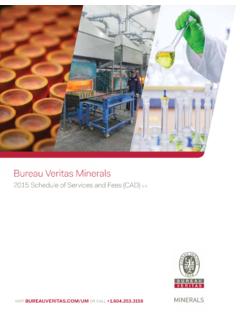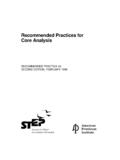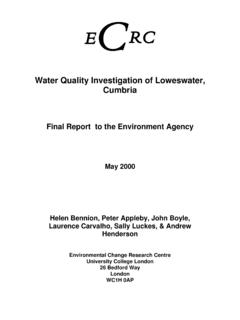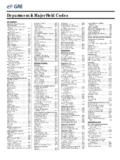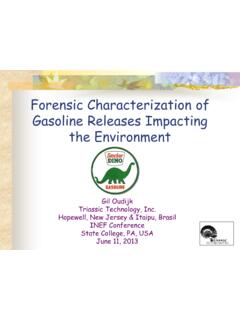Transcription of Fluoride in Drinking-water - who.int
1 Fluoride in Drinking-water World Health Organization titles with IWA Publishing Water Quality: Guidelines, Standards and Health edited by Lorna Fewtrell and Jamie Bartram. (2001). WHO Drinking-water Quality Series Assessing Microbial Safety of Drinking-water : Improving Approaches And Methods edited by Al Dufour, Mario Snozzi, Wolfgang Koster, Jamie Bartram, Elettra Ronchi and Lorna Fewtrell. (2003). Fluoride in Drinking-water edited by K. Bailey, J. Chilton, E. Dahi, M. Lennon, P. Jackson and J. Fawell. (2006). Protecting Groundwater for Health: Managing the Quality of Drinking-water Sources edited by Oliver Schmoll, Guy Howard, John Chilton and Ingrid Chorus. (2006). Safe Piped Water: Managing Microbial Water Quality in Piped Distribution Systems by Richard Ainsworth.
2 (2004). Water Treatment and Pathogen Control: Process Efficiency in Achieving Safe Drinking-water by Mark W LeChevallier and Kwok-Keung Au. (2004). WHO Emerging Issues in Water and Infectious Disease Series Heterotrophic Plate Counts and Drinking-water Safety: The Significance of HPCs for Water Quality and Human Health edited by J. Bartram, J. Cotruvo, M. Exner, C. Fricker, A. Glasmacher. (2003). Pathogenic Mycobacteria in Water: A Guide to Public Health Consequences, Monitoring and Management edited by S. Pedley, J. Bartram, G. Rees, A. Dufour and J. Cotruvo. (2004). Waterborne Zoonoses: Identification, Causes and Control edited by Cotruvo, A. Dufour, G. Rees, J. Bartram, R. Carr, Cliver, Craun, R. Fayer, and Gannon.
3 (2004). Water Recreation and Disease: An Expert Review of the Plausibility of Associated Infections, their Acute Effects, Sequelae and Mortality edited by K. Pond. (2005). For further details contact: Portland Customer Services, Commerce Way, Colchester, Essex, CO2 8HP, UK. Tel: +44 (0) 1206 796351; Fax: +44 (0) 1206 799331; Email: or order online at: Also available from WHO Press, World Health Organization, 20 Avenue Appia, 1211 Geneva 27, Switzerland (tel.: +41 22 791 3264; fax: +41 22 791 4857; e-mail: Fluoride in Drinking-water J. Fawell, K. Bailey, J. Chilton, E. Dahi, L. Fewtrell and Y. Magara Published on behalf of the World Health Organization by IWA Publishing, Alliance House, 12 Caxton Street, London SW1H 0QS, UK.)
4 Telephone: +44 (0) 20 7654 5500; Fax: +44 (0) 20 7654 5555; Email: First published 2006. World Health Organization (WHO) 2006. Printed by TJ International (Ltd), Padstow, Cornwall, UK. Apart from any fair dealing for the purposes of research or private study, or criticism or review, as permitted under the UK Copyright, Designs and Patents Act (1998), no part of this publication may be reproduced, stored or transmitted in any form or by any means, without the prior permission in writing of the publisher, or, in the case of photographic reproduction, in accordance with the terms of licences issued by the Copyright Licensing Agency in the UK, or in accordance with the terms of licenses issued by the appropriate reproduction rights organization outside the UK.
5 Enquiries concerning reproduction outside the terms stated here should be sent to IWA Publishing at the address printed above. The publisher makes no representation, express or implied, with regard to the accuracy of the information contained in this book and cannot accept any legal responsibility or liability for errors or omissions that may be made. The opinions expressed in this publication are those of the authors and do not necessarily reflect the views or policies of the International Water Association or the World Health Organization. IWA, WHO and the authors will not accept responsibility for any loss or damage suffered by any person acting or refraining from acting upon any material contained in this publication.
6 Disclaimer The designations employed and the presentation of the material in this publication do not imply the expression of any opinion whatsoever on the part of the World Health Organization concerning the legal status of any country, territory, city or area or of its authorities, or concerning the delimitation of its frontiers or boundaries. Dotted lines on maps represent approximate border lines for which there may not yet be full agreement. The mention of specific companies or of certain manufacturers' products does not imply that they are endorsed or recommended by the World Health Organization in preference to others of a similar nature that are not mentioned. Errors and omissions excepted, the names of proprietary products are distinguished by initial capital letters.
7 All reasonable precautions have been taken by the World Health Organization to verify the information contained in this publication. However, the published material is being distributed without warranty of any kind, either express or implied. The responsibility for the interpretation and use of the material lies with the reader. In no event shall the World Health Organization be liable for damages arising from its use. British Library Cataloguing-in-Publication Data A CIP catalogue record for this book is available from the British Library WHO Library Cataloguing-in-Publication Data Fluoride in Drinking-water / J. Fawell .. [et al.]. - adverse effects. water - standards. exposure. - analysis. purification.
8 , J. Health Organization. ISBN 92 4 156319 2 (NLM classification: QV 282). ISBN 978 92 4 156319 2. ISBN13: 9781900222969 (IWA Publishing). ISBN 1900222965 (IWA Publishing). Table of contents Acknowledgements ix 1. Introduction 1. References 2. 2. environmental occurrence, geochemistry and exposure 5. Fluoride distribution in water 6. Exposure 8. Air 8. Dental products 8. Food and beverages other than water 8. Water 22. Total Fluoride exposure 24. References 24. 3. Human health effects 29. Fluoride metabolism 29. Absorption 29. Distribution 30. Excretion 30. Effects on laboratory animals and in vitro systems 30. Medium and long-term exposure 30. Mutagenicity and related end-points 31. Carcinogenicity 31.
9 Developmental and reproductive toxicity 31. Effects on humans 31. Effects on teeth 32. vi Fluoride in Drinking-water Skeletal effects 33. Cancer 34. Other possible health effects 34. Acute effects 35. References 35. 4. Guidelines and standards 37. Application of the WHO guideline value to local conditions 37. References 39. 5. Removal of excessive Fluoride 41. Method characterization 44. Scale and decentralization 44. Set-up and flow 45. Media and process 46. Bone charcoal 47. Description 47. Preparation 47. Technical configuration 49. Regeneration 51. Design criteria 51. Cost 52. Experience 52. Local customs and beliefs 53. Contact precipitation 53. Description 53. Technical configuration 56. Design criteria 59.
10 Cost 62. Experience 62. Nalgonda 62. Description 62. Technical configuration 64. Design criteria 64. Cost 65. Sludge disposal 65. Experience 65. Activated alumina 69. Description 69. Technical configuration 69. Regeneration 70. Design criteria 70. Table of Contents vii Cost 71. Experience 71. Clay 72. Description 72. Technical configuration 72. Regeneration 73. Design criteria 73. Hygienic precautions 74. Cost 75. Experience 75. Evaluation and selection of method 75. References 79. 6. Analytical methods 83. Ion-chromatography with chemical suppression of eluent conductivity 84. Ion-selective electrode method 86. Complexone method 1 (laboratory test) 89. Complexone method 2 (field test) 91. SPADNS method 93.











